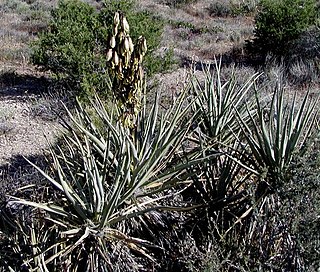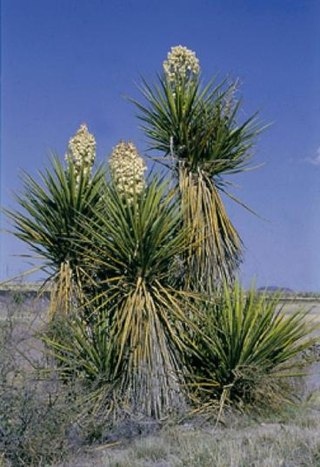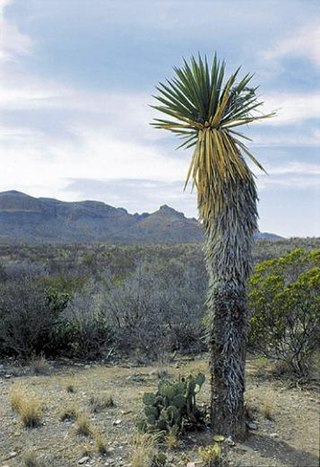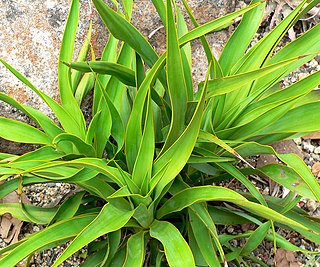
Yucca brevifolia is a plant species belonging to the genus Yucca. It is tree-like in habit, which is reflected in its common names.

Yucca baccata is a common species of yucca native to the deserts of the southwestern United States and northwestern Mexico, from southeastern California north to Utah, east to western Texas and south to Sonora and Chihuahua. It is also reported in the wild in Colombia.

Yucca elata is a perennial plant, with common names that include soaptree, soaptree yucca, soapweed, and palmella. It is native to southwestern North America, in the Sonoran Desert and Chihuahuan Desert in the United States, southern Nevada, southwestern Utah, and northern Mexico. Yucca elata is widely distributed, although its population appears to be decreasing.

Yucca filamentosa, Adam's needle and thread, is a species of flowering plant in the family Asparagaceae native to the southeastern United States. Growing to 3 metres tall, it is an evergreen shrub valued in horticulture.

Yucca rostrata also called beaked yucca, is a tree-like plant belonging to the genus Yucca. The species is native to Texas, and the Chihuahua and Coahuila regions of Mexico. This species of Yucca occurs in areas that are arid with little annual rainfall.

Quercus arkansana, the Arkansas oak, is a species of oak tree. It is native to the southeastern United States. It is threatened by use of its habitat for pine plantations, clearing of land, and diebacks that may be caused by drought.

Tegeticula yuccasella, the yucca moth, is a moth of the family Prodoxidae. The species was first described by Charles Valentine Riley in 1872. It can be found in North America from Texas to southern Canada.

Yucca glauca is a species of perennial evergreen plant, adapted to xeric (dry) growth conditions. It is also known as small soapweed, soapweed yucca, Spanish bayonet, and Great Plains yucca.

Yucca faxoniana is a bladed evergreen shrub of the genus Yucca. It is known by the common names Faxon yucca,Spanish dagger, and giant dagger.
Tegeticula intermedia is a moth of the family Prodoxidae. Along with other moth species, it is commonly known as a yucca moth. T. intermedia lives in North America, particularly the United States. The moth resides in the southwest, the Great Plains, the Southeast, and mid-Atlantic. It also has been found much farther north in regions of Canada like Ontario and Alberta. There are also notable populations present in New Mexico. Their habitats are diverse and vary in terms of climate, landscape, and other factors. The moth lives in sand dunes, forests, glades, grassland, desert, and forests from the East Coast to the Southwest. Yucca moths have developed a strong mutualism with the yucca plant, such that both depend on each other for survival. The yucca moths and yucca plants have coevolved over millions of years. However, Tegeticula intermedia differs from most yucca moths in that it exhibits cheating behavior by laying eggs without pollinating the yucca plant.

Yucca flaccida, commonly called Adam's needle or weak-leaf yucca, is a species of flowering plant in the asparagus family (Asparagaceae). It is native to south-central and southeastern North America, from the lower Great Plains eastward to the Atlantic seaboard in Virginia, south through Florida and the Gulf states. Its natural habitat is in sandy open woodlands and fields. It is not considered to be threatened by the IUCN.

Yucca angustissima, the narrowleaf yucca, is a plant in the family Agavaceae, known as the "narrow-leaved yucca." It is native to Arizona, New Mexico, Colorado and Utah, but grown elsewhere as an ornamental.

Yucca baileyi is a plant in the family Agavaceae. It is native to Utah, Arizona, New Mexico and Colorado but has been cultivated elsewhere. Much of its native range is within the boundaries of the Navajo (Diné) Reservation, hence the common name "Navajo yucca." The Navajo people make extensive use of yucca fibers to make a wide assortment of useful and ceremonial items. They also use the roots as soap. It is not considered to be threatened, as it has a large range and an overall stable population.

Yucca carnerosana, commonly known as the giant Spanish dagger, is a species of North American plant in the asparagus family that grows in arid and desert climate areas. In the United States, it is confined to only a few counties in western Texas, where endemic populations are found in rocky outcrops. The species is, however, widely distributed in northern Mexico. It has a wide range and is abundant, and although it has local threats, its population appears to be stable overall.

Yucca constricta known by the common name "Buckley's yucca," is a plant in the family Asparagaceae. It is found in rocky limestone hills of central and eastern Texas, and also in Coahuila, Mexico.
Yucca necopina Shinners, the Brazos River yucca or Glen Rose yucca, is a species in the family Asparagaceae. It is a rare endemic native to a small region in north-central Texas.

Yucca thompsoniana, the Thompson's yucca, is a plant in the family Asparagaceae, native to Texas, Chihuahua and Coahuila. Other names for the plant include Beaked yucca, Soyate and Palmita.

Yucca rupicola is a plant in the family Asparagaceae, known as the twistleaf yucca, twisted-leaf yucca, Texas yucca or twisted-leaf Spanish-dagger. The species was described by George Heinrich Adolf Scheele in 1850. This is a small, acaulescent plant with distinctive twisted leaves. It is native to the Edwards Plateau region of Texas and also to northeastern Mexico.

Yucca treculianaCarrière is a species of flowering plant in the family Asparagaceae, native to Texas, New Mexico and Coahuila. Common names include Spanish dagger, Spanish bayonet and Don Quixote's lance.
Yucca tenuistyla is a species of flowering plant in the family Asparagaceae found in brushlands near the coast of Texas, at elevations below 200 m. Common names include white-rimmed yucca and whiterim yucca.


















